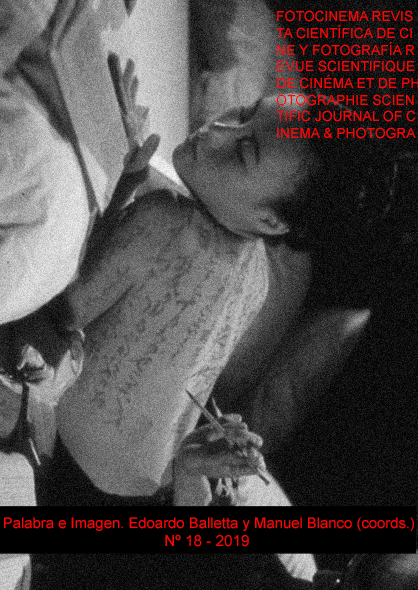About the discursive dimension of photography in the sixties: a genealogy of the documentary side of concept art
DOI:
https://doi.org/10.24310/Fotocinema.2019.v0i18.5534Keywords:
Photography, visual indifference, conceptual art, narratives, contemporary artAbstract
The present article analyzed the incorporation of photography as a full member in contemporary art, from the perspective that places it in the documentary aspect and extremely banalized of the concept art territories. To do this, photography is firstly addressed in its realignment with the everyday and the anodyne of authors like Ed Ruscha who immerse photography in a new discursive dimension never before raised. Then, the artistic discourse of L. Sultan and M. Mandel is analyzed, where, through an aesthetic of estrangement, they achieve to situate photography in the focus of the documentary aspect of concept art. To get to the point of how, from the strategies of amateurism, the photo reach to force the gaze from its own forms of appearance, in a new image far from the documentary and definitively settled in the artistics territories.
Downloads
Metrics
Publication Facts
Reviewer profiles N/A
Author statements
Indexed in
-
—
- Academic society
- N/A
- Publisher
- Universidad de Málaga
References
Arnheim, R. (1980). Arte y entropía. Madrid. Ed. Alianza Forma.
Augé, M. (2000). Los “No lugares”, espacios del anonimato: una antropología de la modernidad. Barcelona. Ed. Gedisa.
Benjamin, W. (2001). Poesía y capitalismo. Iluminaciones II. Madrid. Ed. Taurus.
Biber, K. (2011). Evidence from the Archive: Implementing the Court Information Act. NSW. Sidney Law. 33:575.
Buchloh, B. H.D. (2004). El arte conceptual de 1962 a 1969: De la estética de la administración a la crítica de las instituciones. En. Formalismo e Historicidad. Modelos y métodos en el arte del s. XX. Madrid. Ed. Akal.
Cameron, D. (1990). Love in Ruins. En. Ed. Ruscha: Paintings. Ed. Rotterdam: Museo Boymans Van-Beuningen.
Coplans, J. (1965). Entrevista con Edward Ruscha. Artforum, febrero.
Crow, T. (2002). El arte moderno en la cultura de lo cotidiano. Madrid. Ed. Akal.
Danto, A. C. (2002). Introducción: moderno, posmoderno y contemporáneo. En. Después del fin del arte. El arte contemporáneo y el linde de la historia. Barcelona. Ed. Paidós.
Del Río García, V. (2008). Fotografía Objeto. La superación de la estética del documento. Salamanca. Ed. Universidad de Salamanca.
Díez Cabrera, E. (2005). Edward Ruscha: Artista universal en los ángeles. Revista del Departamento de Historia del Arte, Universidad de La Rioja. dialnet.unirioja.es
Fernández, H. (1999). Fotografía Pública: Photography in Print 1919-1939, Madrid. MNCARS/Aldeasa.
Graham, D. (1967). The Book as Object. Arts, 1965-1969. Ed. CGAC.
Hulten, P. (1990). Writing on a Picture. En. Ed. Ruscha: Paintings. Los Ángeles. Ed. Rotterdam: Museo Boymans Van-Beuningen.
Jean, M. (2008). Tractatus Logico-Catalogicus: Ed. Ruscha. En. La boîte verte. nº 28 noviembre.
Monteiro-Schenkel, C. (2013). Entre arquivos e museus: o deslocamento de imagens em trabalhos de arte contemporânea. Anais do VI Seminário Nacional de Pesquisa em Arte e Cultura Visual Goiânia-G O: UFG, FAV.
Mandel, M; Sultan, L. (2006). Berlin Bienale für Zeitgenössische Kunst/4th. Berlin Bienal for Contermporary Art Catálogo, Berlín. Ed. Hatje Cantz.
Martín, R. (2014). En términos pictóricos: un recorrido por los paisajes y figuras de la cotidianeidad. En. Catálogo de Víctor Ligorred. Figuras y paisajes contemporáneos. Zaragoza. Ed. Diputación Provincial de Zaragoza (DPZ).
Marchán, S. (2002). Del arte objetual al arte de concepto. Epílogo sobre la sensibilidad postmoderna. Madrid. Ed. Akal.
Lippard, L. R. (2004). Seis Años: La desmaterialización del objeto artístico de 1966 a 1972. Madrid. Ed. Akal.
Lloid, J. (1998). Ed. Ruscha, Flanéur. En Ed. Ruscha: Recent Works on Paper. Catálogo de la exposición celebrada en la Karsten Schubert Gallery (Londres), 29 de junio al 13 de agosto de 1988. Londres. Ed. Karsten Schubert Ltd.
Lyotard, J. F. (2006). La condición posmoderna. Madrid. Cátedra.
Owens, C. (1992). Photography en abyme. En Beyond Recognition. Representation, Power, and Culture. California. Ed. University of California Press.
Padilla, A. J. (2014). La virtualidad como elemento disolutivo del objeto artístico en el arte contemporáneo. Obra Digital. Revista de Comunicación. UVIC Universitat Central de Catalunya. Nº 6 Febrero.
Silbertein, L. J. (2000). Mapping Jewish Identities. Nueva York. Ed. New York University Press.
Szarkowski, J. (2010). El ojo del fotógrafo. Madrid. La Fábrica Editorial.
Wall, J. (2003). Señales de indiferencia: aspectos de la fotografía en el arte conceptual o como arte conceptual. En. Picazo, G. Ribalta J. Indiferencia y singularidad. Barcelona. Ed. Gustavo Gili.
Wollen, P. (2000). Vectores de melancolía. Papel Alpha. Cuadernos de fotografía, nº5.
Downloads
Published
How to Cite
Issue
Section
License
All contents published in Fotocinema Revista científica de cine y fotografía are protected under the Creative Commons Attribution-NonCommercial-ShareAlike 4.0 International (CC BY-NC-SA 4.0) license. All about this license is available in the following link: <http://creativecommons.org/licenses/by-nc-sa/4.0>
Users can copy, use, redistribute, share and exhibit publicly as long as:
- The original source and authorship of the material are cited (Journal, Publisher and URL of the work).
- It is not used for comercial purposes.
- The existence of the license and its especifications are mentioned.
There are two sets of authors’ rights: moral and property rights. Moral rights are perpetual prerogatives, unrenounceable, not-transferable, unalienable, imprescriptible and inembargable. According to authors’ rights legislation, Fotocinema. Revista científica de cine y fotografía recognizes and respects authors moral rights, as well as the ownership of property rights, which will be transferred to University of Malaga in open access. The property rights are referred to the benefits that are gained by the use or the dissemination of works. Fotocinema. Revista científica de cine y fotografía is published in an open access form and it is exclusively licenced by any means for doing or authorising distribution, dissemination, reproduction, , adaptation, translation or arrangement of works.
Authors are responsable for obtaining the necessary permission to use copyrighted images.














13.png)



